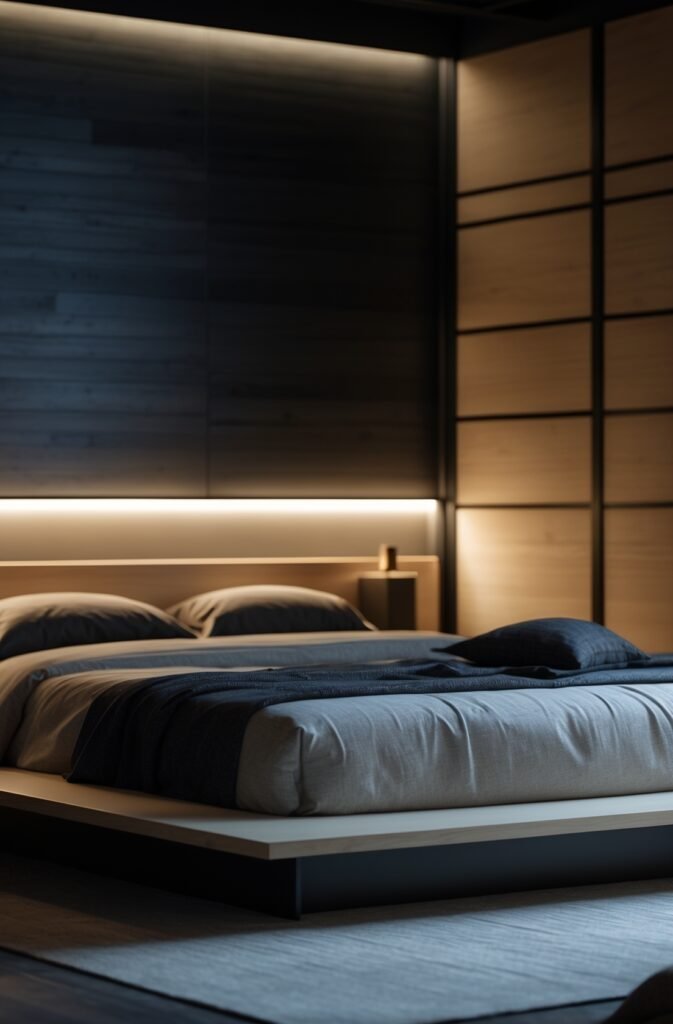
Escape the Noise: Designing a Serene Minimalist Bedroom
In today’s fast-paced world, our homes, especially our bedrooms, should be sanctuaries of peace and tranquility. The modern minimalist aesthetic, often blended with the warmth and natural elements of Japandi design (a hybrid of Japanese and Scandinavian styles), offers a perfect blueprint for creating such a space. This approach prioritizes simplicity, functionality, and a deep connection to natural materials, resulting in a calming atmosphere conducive to rest and rejuvenation, as beautifully illustrated in the featured bedroom design.
The Core Principles: Minimalism Meets Nature
The featured bedroom exemplifies key principles of modern minimalist and Japandi design:
- Simplicity and Clean Lines: Notice the uncluttered surfaces, the low-profile platform bed, and the integrated design elements like the headboard lighting. Furniture is chosen for its function and form, avoiding unnecessary ornamentation.
- Natural Materials: Wood takes center stage, showcasing its inherent beauty and texture. The contrast between the dark, almost charcoal-toned wall paneling and the lighter, warm wood of the headboard and side panels creates visual interest without overwhelming the senses.
- Emphasis on Light and Shadow: Strategic lighting plays a crucial role. The integrated LED strip above the headboard casts a warm, ambient glow, highlighting the texture of the dark wood and creating a cozy atmosphere. The interplay of light and shadow adds depth and dimension to the space.
- Neutral Color Palette: The foundation rests on a sophisticated blend of neutrals – deep charcoals, warm beiges, soft greys, and grounding blacks – punctuated by the warmth of the lighting. This creates a calming and cohesive environment.
Deconstructing the Palette: Moody Hues and Warm Woods
Color is used intentionally here to evoke a specific mood. The dominant dark wood paneling (#2A2A2B) behind the bed creates a sense of intimacy and grounding. This is balanced by the lighter wood tones (#B89F80) of the integrated headboard and the adjacent wall feature, preventing the space from feeling overly heavy. The bedding introduces soft greys (#A8A8AC, #3E434A), adding layers of comfort and subtle contrast. The warm glow of the integrated lighting (#F2D6A2) acts as a crucial accent, infusing the space with warmth and preventing the darker tones from feeling cold. A mid-tone grey (#6C6F73) on the floor or rug anchors the scheme.
Tip: When working with dark walls, ensure sufficient lighting, both natural and artificial. Incorporating lighter wood tones, reflective surfaces (though minimally in Japandi), and soft textiles helps maintain balance.
The Power of Texture
In a minimalist space where color and pattern are restrained, texture becomes paramount for adding depth and interest. This bedroom masterfully employs various textures:
- Wood Grain: The natural grain of both the dark and light wood panels provides organic visual detail and tactile appeal.
- Woven Fabrics: The bedding, likely cotton or linen, offers softness and comfort. The subtle weave of the sheets and the richer texture of the darker throw blanket add layers of tactile experience. The floor appears to have a low-pile, woven rug, adding softness underfoot.
- Matte Finishes: The bed platform base and potentially other structural elements feature smooth, matte finishes, contributing to the understated and sophisticated feel.
Tip: Layer different textures within a similar color family to create richness without clutter. Think linen sheets, a wool throw, a wood nightstand, and a ceramic lamp.
Illuminating the Design: Strategic Lighting
Lighting is not an afterthought here; it’s integral to the design. The recessed LED strip lighting above the bed serves multiple purposes: it provides soft, ambient light perfect for winding down, highlights the feature wall’s texture, and eliminates the need for bulky bedside lamps, reinforcing the minimalist aesthetic. Additional subtle lighting likely exists elsewhere in the room (perhaps recessed ceiling lights or a minimal floor lamp, though not visible) to ensure adequate overall illumination. The key is layered, indirect lighting that creates mood rather than harsh brightness.
Tip: Install dimmers on all light sources to control the ambiance. Consider integrated lighting solutions within shelving, headboards, or ceiling coves for a seamless look.
Achieving Your Own Minimalist Sanctuary
Inspired to create a similar retreat? Here’s how:
- Declutter Ruthlessly: Minimalism starts with removing the non-essential. Keep only items you love or need. Find smart storage solutions to keep surfaces clear.
- Choose a Neutral Base: Start with a palette of neutrals – greys, beiges, whites, blacks, or deep blues/greens.
- Incorporate Natural Wood: Introduce wood elements through furniture, flooring, or wall paneling. Mix tones carefully for balance.
- Layer Textures: Bring in natural fabrics like linen, cotton, wool, and jute through bedding, rugs, and curtains.
- Focus on Lighting: Plan for layered lighting – ambient, task, and accent. Opt for warm light temperatures (around 2700K-3000K) for a cozy feel.
- Select Simple Furniture: Choose pieces with clean lines, functional design, and quality construction. Low-profile beds enhance the sense of space.
- Keep Decor Minimal: Select a few meaningful decorative items rather than cluttering shelves. Think a single piece of art, a beautiful vase, or a couple of books.
By embracing simplicity, natural materials, and thoughtful details, you can transform your bedroom into a modern minimalist haven that promotes rest, relaxation, and a profound sense of calm. This Japandi-inspired approach isn’t just a style; it’s a philosophy for creating a more intentional and peaceful living space.
